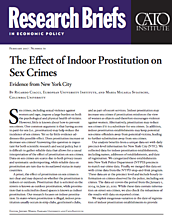A priori, the effect of prostitution on sex crimes is not clear and may depend on whether the prostitution is indoors or outdoors. Prostitution that is solicited on the streets is known as outdoor prostitution, while prostitution that is solicited in closed spaces is known as indoor prostitution. Our research focuses on indoor prostitution. In states where prostitution is illegal, indoor prostitution usually occurs in strip clubs, gentlemen’s clubs, and as part of escort services. Indoor prostitution may increase sex crimes if prostitution reinforces the view of women as objects and therefore encourages violence against women. Alternatively, prostitution may reduce sex crimes if it is a substitute for sex crimes. In addition, indoor prostitution establishments may keep potential sex-crime offenders away from potential victims, leading to further substitution away from sex crimes.
Our analysis benefits from a unique data set with daily precinct-level information for New York City (NYC). We collected data for indoor prostitution establishments, including names, addresses of establishments, and date of registration. We categorized these establishments into New York Police Department (NYPD) precincts to match our crime data. Finally, we merged this data set with crime data from the NYPD stop-and-frisk program. These data are at the precinct level and include hourly information on crimes observed by the police, including sex crimes. The data set covers the period from the January 1, 2004, to June 30, 2012. While these data contain information on street sex crimes, we also check the robustness of the results with data on reported crime.
We exploit exogenous variation in the date of registration of indoor prostitution establishments to provide causal evidence of these establishments on sex crimes using crime data at the daily level. Our main assumption is that the date of registration of such establishments is not linked with variables correlated with sex crimes. That is, we assume that the opening date of an indoor prostitution business is independent of any other factor affecting sex crimes.
We find that the presence of an indoor prostitution establishment in a given precinct leads to a 0.4 percent daily reduction in sex crimes per precinct. Furthermore, relative to outdoor prostitution, indoor prostitution establishments are less likely to be correlated with unobservable characteristics that affect sex crimes, as indoor prostitution establishments allow the whole transaction to occur behind closed doors. In the United States, indoor prostitution is the major source of prostitution and is estimated to constitute roughly the 85 percent of all sex work activity.
These results also shed light on the mechanisms behind the effect of indoor prostitution on sex crimes. We find that sex crime is reduced since potential sex offenders are indoor prostitutes’ customers. We name this mechanism the potential criminal channel. Our results suggest the magnitude of the negative effect of the establishments is larger at night. Since it is also at night when the majority of the indoor prostitution establishments are open and the demand for the services they provide is higher, the results suggest that potential sex offenders prefer to use the services offered by these establishments rather than committing sex crimes. Furthermore, these results suggest that sex crimes and indoor prostitution are substitutes.
Using our data we are also able to rule out other mechanisms such as an increase in the number of police officers or a reduction of potential victims in areas where these businesses opened. Consistent with the fact that results are not driven by increased policing or endogenous crime reporting in the data, we find that the openings do not affect other types of crimes. In addition, we do not find evidence of negative spillover effects on bordering precincts, find no effects of reallocation to bordering districts, and do not find that the establishments affect reallocation of street sex workers. This suggests that results are not driven by a reduction of potential victims avoiding the area.
Our results thus suggest that indoor prostitution establishments reduce sex crimes and also that this effect occurs because potential sex offenders attend indoor prostitution establishments instead of committing sex crimes. Some policymakers might argue that the opening of these establishments is positive since they decrease the total number of sex crimes while they do not affect other crimes such as use of drugs or burglaries. Other policymakers might argue that the sector of indoor prostitution should be supervised since some of their customers are potential sex offenders. In either case, our work sets the grounds for policymakers to take into account the effect of indoor prostitution on sex crimes when discussing how to legislate prostitution.
NOTE:
This research brief is based on Riccardo Ciacci and Maria Micaela Sviatschi, “The Effect of Indoor Prostitution on Sex Crime: Evidence from New York City,” November 25, 2016, http://www.micaelasviatschi.com/wp-content/uploads/2016/05/ sex_crimeNYC.pdf.
